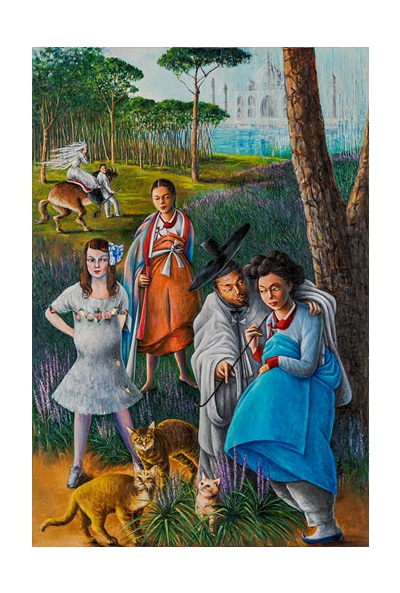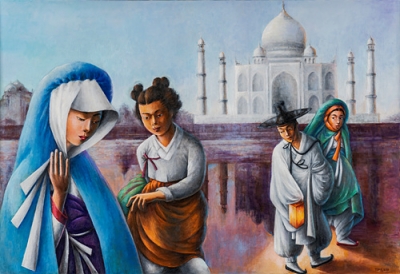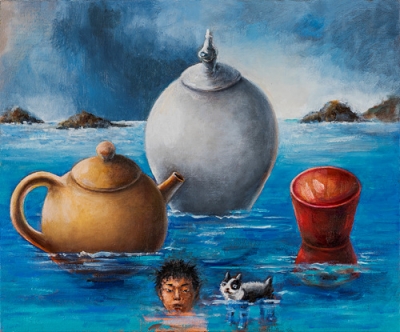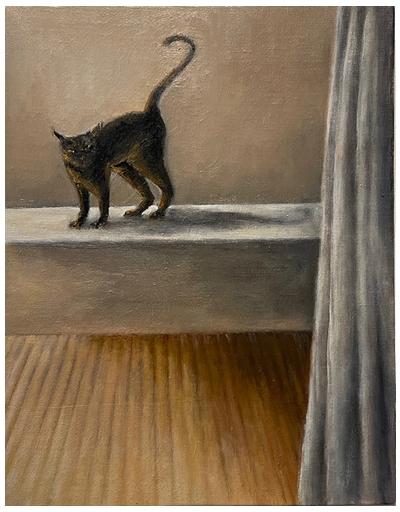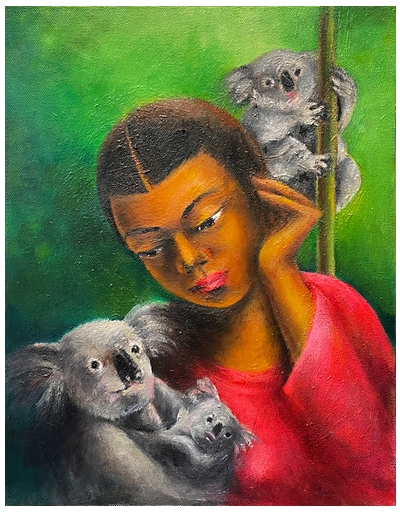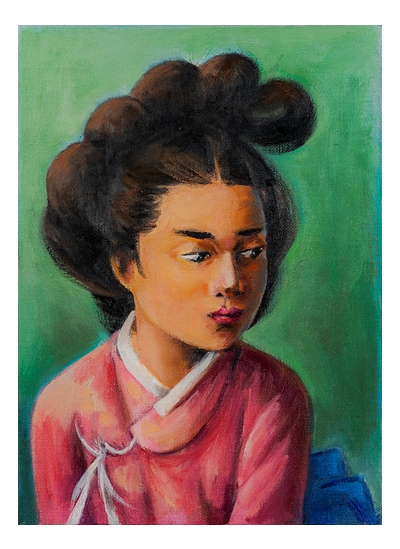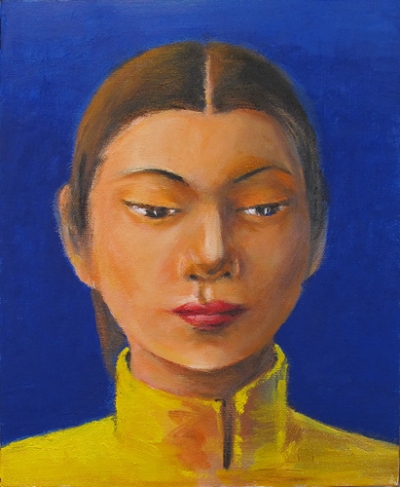ARTISTS
Ted K(b.1958 Korean)
VR View
About
In recent works, classic masterpieces and Korean 18th-century genre paintings use figures from Shin Yun-bok's paintings to arbitrarily place various characters anywhere in the world, such as India's Taj Mahal, to form a screen. The scenery in the painting can be anywhere he has been, or anywhere in the world he has never been, seen through the media.
The artist expresses the artist's inner psychology through expressions and poses of expressionless characters in a theatrical space illuminated in the dark, and wants to show an awkward but strange space where the present, past, and imagination exist.
- Open ending and psychological mise-en-scene
As in mystery movies, the character's momentary expressions provide more information than expected, while attracting countless imaginations. The expression is not a complete expression of sincerity, and the background surrounding the character is not the completion of the story. It's always a deficiency, so it breeds wild imagination and speculation, but thanks to it, the story expands and enriches. In other words, this world, which is designed so that all the truth cannot be known by our perception, is a movie in itself and life is a mise-en-scene composed of editing.
- A quantum world, the mystery in it
His background is quantum. It is not the present, it is not the past, it is not the future, and it is a new type of time and space that our perception has never experienced. As if wary of becoming clearer, fragmented images are scattered throughout his canvas, and if this directing paid more attention to the aesthetic sense on the screen, the narratives he conveys are more internal and psychological. His image, which consists of quantum time in which the East and the West intersect at the same time and the past and the present coexist, shows a strange, awkward, and paradoxically extremely secular mise-en-scene. Characters who reveal their existence in illogical spacetime and short snapshots have alibi in the background. Described as descriptions like montage of criminals, they seem to be hiding their secrets all the time with a unique atmosphere without lines. His montage is a symbol of irony and satire hidden in the story, and these symbols are a device that brings tension and mystery to the audience. The coexistence of images that cannot coexist conveys a strange psychological tension and narrative. Miseensen, strangely created by arranging fragmented cuts and cuts, provides psychological clues to the characters, but remains a question. No one knows the hidden underlying circumstances of these montage. The mystery and inexplicable suspense are also about the author's view of the world. This is because the world he sees with his eyes, observations and thoughts about characters are melted in his symbolic mise en. It may mean that the world remains an unsolved case for the author.
A mystery play that starts with "Open Ending"
What is certain is that thanks to the symbolic image that feels extreme, the biggest impression of his work is "story, extreme." It's like if you edit the main scenes of several movies, it's a new parody.k.a. a new parody. The world in which time and space overlap with the symbolic symbols he created is a world that does not exist and a world that exists cinematically. If you follow the play he edited, you eventually reach the world of open ending as an entrance to another dimension presented by the artist. The unprecedented world becomes real as soon as it is observed. Ted K's exhibition is about the real but unobserved quantum world, the characters living in it.
The artist expresses the artist's inner psychology through expressions and poses of expressionless characters in a theatrical space illuminated in the dark, and wants to show an awkward but strange space where the present, past, and imagination exist.
- Open ending and psychological mise-en-scene
As in mystery movies, the character's momentary expressions provide more information than expected, while attracting countless imaginations. The expression is not a complete expression of sincerity, and the background surrounding the character is not the completion of the story. It's always a deficiency, so it breeds wild imagination and speculation, but thanks to it, the story expands and enriches. In other words, this world, which is designed so that all the truth cannot be known by our perception, is a movie in itself and life is a mise-en-scene composed of editing.
- A quantum world, the mystery in it
His background is quantum. It is not the present, it is not the past, it is not the future, and it is a new type of time and space that our perception has never experienced. As if wary of becoming clearer, fragmented images are scattered throughout his canvas, and if this directing paid more attention to the aesthetic sense on the screen, the narratives he conveys are more internal and psychological. His image, which consists of quantum time in which the East and the West intersect at the same time and the past and the present coexist, shows a strange, awkward, and paradoxically extremely secular mise-en-scene. Characters who reveal their existence in illogical spacetime and short snapshots have alibi in the background. Described as descriptions like montage of criminals, they seem to be hiding their secrets all the time with a unique atmosphere without lines. His montage is a symbol of irony and satire hidden in the story, and these symbols are a device that brings tension and mystery to the audience. The coexistence of images that cannot coexist conveys a strange psychological tension and narrative. Miseensen, strangely created by arranging fragmented cuts and cuts, provides psychological clues to the characters, but remains a question. No one knows the hidden underlying circumstances of these montage. The mystery and inexplicable suspense are also about the author's view of the world. This is because the world he sees with his eyes, observations and thoughts about characters are melted in his symbolic mise en. It may mean that the world remains an unsolved case for the author.
A mystery play that starts with "Open Ending"
What is certain is that thanks to the symbolic image that feels extreme, the biggest impression of his work is "story, extreme." It's like if you edit the main scenes of several movies, it's a new parody.k.a. a new parody. The world in which time and space overlap with the symbolic symbols he created is a world that does not exist and a world that exists cinematically. If you follow the play he edited, you eventually reach the world of open ending as an entrance to another dimension presented by the artist. The unprecedented world becomes real as soon as it is observed. Ted K's exhibition is about the real but unobserved quantum world, the characters living in it.
Follow Gallery
Affiliation
Educational background
1984 Graduated from Chicago University of the Arts, majoring in painting and drawing
1981 Graduated from Hongik University College of Fine Arts, Department of Western Painting
1981 Graduated from Hongik University College of Fine Arts, Department of Western Painting
Awards
Artwork Location
Exhibition and project history
a private exhibition
2022 Nanum Gallery Blue, Songchu, Gyeonggi-do
2021 Avang Gallery Cafe, Yongsan, Seoul
Group Exhibition
2019 France City Hall, France, France
2018 Hongik University 77 Forever Exhibition, Mapo, Seoul
2015 SAIC 150th Anniversary Exhibition, Mapo, Seoul
an art fair
2021 to 2019 – Hwarang Art Festival, COEX, Seoul
2021 to 2019 – Kiaf, COEX, Seoul
2019 – Busan Art Fair, Busan
2022 Nanum Gallery Blue, Songchu, Gyeonggi-do
2021 Avang Gallery Cafe, Yongsan, Seoul
Group Exhibition
2019 France City Hall, France, France
2018 Hongik University 77 Forever Exhibition, Mapo, Seoul
2015 SAIC 150th Anniversary Exhibition, Mapo, Seoul
an art fair
2021 to 2019 – Hwarang Art Festival, COEX, Seoul
2021 to 2019 – Kiaf, COEX, Seoul
2019 – Busan Art Fair, Busan
Ted K(b.1958 Korean) Art works

